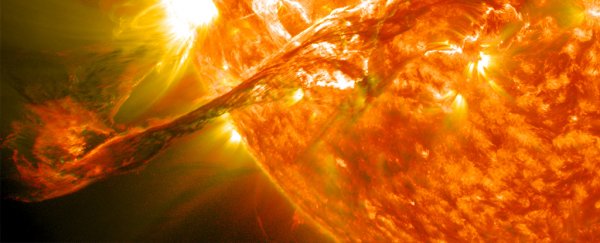Scientists have discovered that the massive bursts of solar activity we call 'solar tornadoes' are not at all like the twisters we get here on Earth - even though they sure appeared similar on a gigantic scale.
The term describes the enormous eruptions of gas that appear to swirl up from the Sun's surface, but based on a new analysis of their structure, these swirls aren't moving in the way astronomers have always assumed.
Research on the phenomenon is due to be presented at the European Week of Astronomy and Space Science (EWASS) in Liverpool this week, correcting more than a century of thought on what were once called 'tornado prominences'.
"They are associated with the legs of solar prominences – these are beautiful concentrations of cool plasma in the very hot solar corona that can easily be seen as pink structures during total solar eclipses," says lead author Nicolas Labrosse from the University of Glasgow.
Spectacular whirls of gas spilling from the Sun were first noted as far back as 1868, and since then observations have led to us to picture them as huge, vertical, gyrating storms of plasma that superficially resemble our own tornadoes.
They've been described as being big enough to swallow our planet whole several times over, reaching half the distance between Earth and the Moon.
As recently as a few years ago, moving images of these monsters captured by NASA's Solar Dynamic Observatory have certainly given them an appearance of a glowing twister spiralling far into space:
 (NASA/SDO/AIA/Aberystwyth University/Li/Morgan/Leonard)
(NASA/SDO/AIA/Aberystwyth University/Li/Morgan/Leonard)
The problem is these images are little more than a series of two-dimensional photographs, reducing this streaming of gas to a flat, writhing ribbon.
To really get a solid idea of what's behind these solar projections, astronomers made use of the Doppler effect to add an element of depth. This is more or less the same physical process that helps us determine whether a siren is approaching or receding by changes in its pitch.
In a series of recent studies, researchers built a 3D map of these structures and discovered how magnetic fields and differences in gas pressures combine to channel plasma into these superheated streams.
As it turns out, Far from being a swirling finger pointing away from the Sun, these 'tornadoes' are actually horizontal. They contain knots of gas moving at speeds of around 65 kilometres (40 miles) per second along an 80,000 kilometre (50,000 mile) long magnetic track that runs roughly parallel to the surface.
Really, it's a rather easy mistake to have made, based on the evidence we had at hand. The confusion came down to the flattened perspective of the horizontal trail of plasma captured from space.
"The overall effect is similar to the trail of an aeroplane in our skies," says Labrosse.
"The aeroplane travels horizontally at a fixed height, but we see that the trail starts above our heads and ends up on the horizon. This doesn't mean that it has crashed!"
To think we've been thinking these churning horizontal fields were vertical thanks to the same camera trick we use to pretend we're pushing over the Leaning tower of Pisa.
"Perhaps for once the reality is less complicated than what we see!" says astrophysicist Brigitte Schmieder from the Observatoire de Paris.
"Solar tornadoes sound scary but in fact they normally have no noticeable consequences for us. However, when a tornado prominence erupts, it can cause what's known as space weather, potentially damaging power, satellite and communication networks on Earth."
We're increasingly reliant on delicate electronic technology in our communications and computations, meaning space weather is something we're needing to quickly get a handle on.
Solar tornadoes might not be a direct threat, but knowing more about their place in the complicated dance of magnetic fields just might give us the clues we need to predict and prepare for dangerous eruptions.
This research was published in Astronomy and Astrophysics and The Astrophysical Journal. Reports can be found on arxiv.org here, here, here, here, and here.
